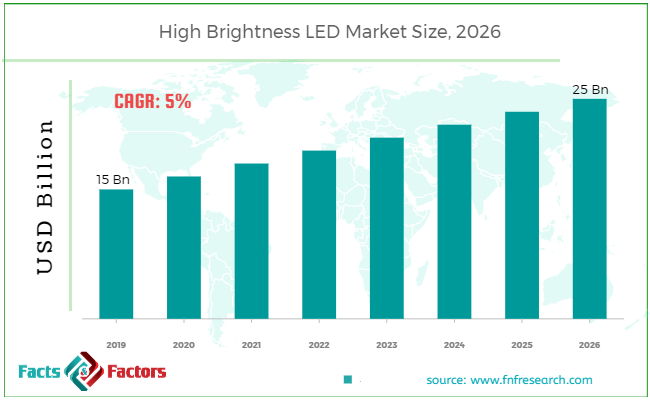Search Market Research Report
High Brightness LED Market Size, Share Global Analysis Report, 2020–2026

High Brightness LED Market By Application (Automotive Application, General Lighting, Backlighting, Mobile, Signals & Signage, Others): Global Industry Outlook, Market Size, Business Intelligence, Consumer Preferences, Statistical Surveys, Comprehensive Analysis, Historical Developments, Current Trends, and Forecast 2020–2026
Industry Insights
[195+ Pages Report] According to the report published by Facts Factors, the global high brightness LED market size was worth around USD 15 billion in 2019 and is predicted to grow to around USD 25 billion by 2026 with a compound annual growth rate (CAGR) of roughly 5% between 2020 and 2026. The report analyzes the global high brightness LED market drivers, restraints/challenges, and the effect they have on the demands during the projection period. In addition, the report explores emerging opportunities in the high brightness LED market.

This specialized and expertise oriented industry research report scrutinizes the technical and commercial business outlook of the high brightness LED industry. The report analyzes and declares the historical and current trends analysis of the high brightness LED industry and subsequently recommends the projected trends anticipated to be observed in the high brightness LED market during the upcoming years.
The high brightness LED market report analyzes and notifies the industry statistics at the global as well as regional and country levels in order to acquire a thorough perspective of the entire high brightness LED market. The historical and past insights are provided for FY 2016 to FY 2019 whereas projected trends are delivered for FY 2020 to FY 2026. The quantitative and numerical data is represented in terms of volume (Kilotons), and value (USD billion) from FY 2016 – 2026.
 Key Insights from Primary Research
Key Insights from Primary Research
- According to the primary CXO’s of the global high brightness LED market, the market is estimated to witness a substantial growth of nearly 5% over the forecast period.
- The market was valued at USD 15 billion, in 2019 and is expected to be valued over USD 25 billion.
- By application segmentation, the general lighting category is expected to contribute the largest market share in the global high brightness LED market attributed to changing consumer preferences towards the high brightening LED from traditional LED and rise in the sale of outdoor lights, replacements lamps.
- On the basis of the region, North America led the market in 2019 and it is anticipated to grow in the future years attributed to reduction in LED components cost and mobile devices shipment.
- Increasing consumption of the HBLED in domestic as well as industrial sector is driving the market growth.
 Key Recommendations from Analysts
Key Recommendations from Analysts
- Our analysts recommend that the Asia Pacific dominate the global market for the high brightness LED over the forecast period high adoption of the HBLED in the automobile and commercial application.
- The Europe is anticipated to boost market for the high brightness LED owing to high implementation of HBLED lights in buildings and in various industries.
- The automotive application category is anticipated to grow over the forecast period owing to the increasing use of HBLED in automotive industry.
- Owing to the shipment of mobile devices towards HB LED, the mobile category is expected to expand the market during the upcoming years.
- Owing to the companies changing strategy toward advanced and energy efficient LED, high brightness LED market may create numerous opportunities in the market over the forecast period.
 Market Attractiveness by Regional Analysis
Market Attractiveness by Regional Analysis
The quantitative data is further underlined and reinforced by comprehensive qualitative data which comprises various across-the-board market dynamics. The rationales which directly or indirectly impact the high brightness LED industry are exemplified through parameters such as growth drivers, restraints, challenges, and opportunities among other impacting factors.
Throughout our research report, we have encompassed all the proven models and tools of industry analysis and extensively illustrated all the key business strategies and business models adopted in the high brightness LED industry. The report provides an all-inclusive and detailed competitive landscape prevalent in the high brightness LED market.
The report utilizes established industry analysis tools and models such as Porter’s Five Forces framework to analyze and recognize critical business strategies adopted by various stakeholders involved in the entire value chain of the high brightness LED industry. The high brightness LED market report additionally employs SWOT analysis and PESTLE analysis models for further in-depth analysis.
The report study further includes an in-depth analysis of industry players' market shares and provides an overview of leading players' market position in the high brightness LED sector. Key strategic developments in the high brightness LED market competitive landscape such as acquisitions & mergers, inaugurations of different products and services, partnerships & joint ventures, MoU agreements, VC & funding activities, R&D activities, and geographic expansion among other noteworthy activities by key players of the high brightness LED market are appropriately highlighted in the report.
The high brightness LED market research report delivers an acute valuation and taxonomy of the high brightness LED industry by practically splitting the market on the basis of different types, category and regions. Through the analysis of the historical and projected trends, all the segments and sub-segments were evaluated through the bottom-up approach, and different market sizes have been projected for FY 2020 to FY 2026. The regional segmentation of the high brightness LED industry includes the complete classification of all the major continents including North America, Latin America, Europe, Asia Pacific, and Middle East & Africa. Further, country-wise data for the high brightness LED industry is provided for the leading economies of the world.
HBLEDs often referred to as high brightness LEDs or high-power LEDs are used for lighting applications. Compared to conventional LEDs, high brightness LEDs have higher light rates. Such lights are capable of providing high levels of output with greater efficiency than other forms of lighting technology and a much longer lifetime, although they put new demands on technology. It is use in many applications such as automotive lighting, domestic lightning, office lightning, etc.
Increasing energy-saving lighting needs, increasing demands for brighter lights at lower voltage are driving market growth. Strict regulations on energy-saving and the demand for green building and the use of high-brightness LEDs in various applications such as cell phones, street lighting, signals and backlighting, automotive are factors expected to increase demand for HBLED market. However, HB LED performance is depend on ambient temperature, excessive use of HB-LED may cause failure at high temperatures, this factor can restrict market growth. Conversely, increasing penetration of LED in various sectors is expected to create enormous opportunities in the market.
The high brightness LED market is segmented based on application, and region. On the basis of application segmentation, the market is classified into automotive application, general lighting, backlighting, mobile, signals & signage, others.
 Report Scope
Report Scope
Report Attribute |
Details |
Market Size in 2019 |
USD 15 billion |
Projected Market Size in 2026 |
USD 25 billion |
CAGR Growth Rate |
5% CAGR |
Base Year |
2019 |
Forecast Years |
2019-2026 |
Key Market Players |
Epistar Corp, Cree Inc., Philips Lumileds, Moritex Corporation, Samsung Electronics Co Ltd, Seoul semiconductor, Osram Opto Semiconductor, American Bright Optoelectronics Corps, Nichia Corporation, Toyoda Gosei, and others. |
Key Segment |
By Application, By Region |
Major Regions Covered |
North America, Europe, Asia Pacific, Latin America, and the Middle East & Africa |
Purchase Options |
Request customized purchase options to meet your research needs. Explore purchase options |
 Some of the leading players in the global market include
Some of the leading players in the global market include
- Nichia Corporation
- Toyoda Gosei
- Philips Lumileds
- Epistar Corp
- Cree Inc.
- Moritex Corporation
- Samsung Electronics Co Ltd
- American Bright Optoelectronics Corps
- Seoul semiconductor
- Osram Opto Semiconductor
The taxonomy of the high brightness LED industry by its scope and segmentation is as follows:
 By Application Segmentation Analysis
By Application Segmentation Analysis
- Automotive Application
- General Lighting
- Backlighting
- Mobile
- Signals & Signage
- Others
 By Regional Segmentation Analysis
By Regional Segmentation Analysis
- North America
- The U.S.
- Canada
- Europe
- Germany
- The UK
- France
- Spain
- Italy
- Rest of Europe
- Asia Pacific
- China
- Japan
- India
- South Korea
- Southeast Asia
- Rest of Asia Pacific
- Latin America
- Brazil
- Mexico
- Rest of Latin America
- Middle East & Africa
- GCC
- South Africa
- Rest of Middle East & Africa
Industry Major Market Players
- Nichia Corporation
- Toyoda Gosei
- Philips Lumileds
- Epistar Corp
- Cree Inc.
- Moritex Corporation
- Samsung Electronics Co Ltd
- American Bright Optoelectronics Corps
- Seoul semiconductor
- Osram Opto Semiconductor
Frequently Asked Questions

Copyright © 2024 - 2025, All Rights Reserved, Facts and Factors


